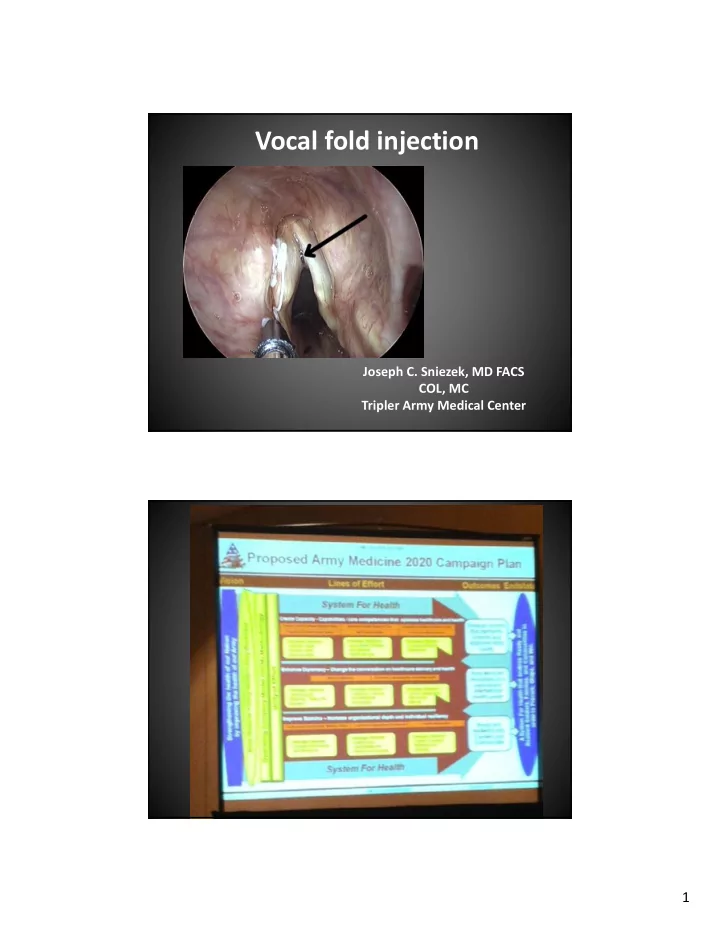

Vocal fold injection Joseph C. Sniezek, MD FACS COL, MC Tripler Army Medical Center 1
Medical Lectures: 1.Me 2.You Injection laryngoplasty 2
Sniezek’s single 5 patients: 2/5 successful injection laryngoplasty in office 2/5 unsuccessful with procedure done subsequently in OR 1/5 ran away claiming voice was fine Medialization Thyroplasty injection medialization 3
Vocal fold injection 1. When 2. What 3. How 4. Why When 1. Vocal fold paresis/paralysis 2. Vocal fold scar 3. VF atrophy 4. Trial injection 4
When NOT to inject Large posterior glottic gap What 1.Gelfoam 2.Collagen (cymetra) 3.Fat 4.Radiesse voice gel 5.Radiesse 5
Gelfoam 1.Lasts only 6 weeks 2.Requires mixing/prep 3.Must use 18g needle to inject Cymetra ‐ Micronized cadaveric dermis ‐ Infection transmission risk? ‐ Lots of mixing 6
Fat injection to vocal fold ‐ liposuction or open harvest ‐ rinse with 1 ‐ 2 liters of saline ‐ soak in insulin (100 unit vial) for 5 minutes ‐ inject lateral and deep ‐ overinject by 30% ‐ 50% ‐ Bruning syringe Radiesse Voice ‐ spherules of calcium hydroxylapatite ‐ suspended in aqueous gel ‐ can pass through 27 g needle (attached needle is 24 g) ‐ forms a scaffolding for tissue ingrowth 7
Radiesse Voice Vocal handicap index scores How ‐ first injection posterior lateral 2 ‐ second inject (if necessary) at 1 lateral mid ‐ TVC ‐ inject 5 mm deep (needle mark) ‐ inject slowly ‐ good injection shows infraglottic augmentation first 8
How ‐ overinject 10 ‐ 20% ‐ over ‐ injecting anteriorly leads to strained voice Office vs. OR injection Office OR Avoid general anesthesia GETA with ETT Need good local anesthesia Spontaneous ventilation ‐ local ‐ topical 9
Office ‐ based injection ‐ techniques Trans ‐ thyroid Cartilage ‐ topicalize nasal cavity and larynx ‐ spinal needle through thyroid cartilage at TVC level ‐ inject under NP scope guidance Office ‐ based injection ‐ techniques Trans ‐ thyrohyoid membrane ‐ 1.5 inch 23 or 25 g needle ‐ angle can be a challenge ‐ need local and topical anesthetic 10
Office ‐ based injection ‐ techniques Trans ‐ cricothyroid membrane ‐ Stay submucosal (avoid topical anesthesia) ‐ direct needle up and laterally (1.5 inch) ‐ difficult to determine needle location ‐ 50% in office, 50% in OR ‐ success and complication rate the same ‐ in office: trans ‐ cricothyroid most common 11
OR Injections ETT is a problem OR injection with spontaneous ventilation Photos courtesy of Dr. Ben Cable ‐ recommend peds anesthesiologist ‐ topicalize larynx with 4% licocaine ‐ microscope or telescope 12
Vocal fold injection Conclusions 1. When (paresis, VF scar, atrophy, trial) 2. What (Radiesse) 3. How (office injection vs. spontaneous ventilation in OR) 4. good anesthesia is the key 13
14
Recommend
More recommend